Arika ransomware has continued to evolve since rising as a risk in March, increasing its attain from initially concentrating on Home windows techniques to incorporate Linux servers and using a rising array of ways, methods, and procedures (TTPs).
An in-depth report on Akira from LogPoint breaks down the “highly sophisticated” ransomware, which encrypts sufferer information, deletes shadow copies, and calls for ransom fee for information restoration.
The an infection chain actively targets Cisco ASA VPNs missing multifactor authentication to use the CVE-2023-20269 vulnerability as an entry level.
As of early September, the group had efficiently hit 110 victims, specializing in targets within the US and the UK.
British quality-assurance firm Intertek was a latest high-profile sufferer; the group has additionally focused manufacturing, skilled companies, and automotive organizations.
In accordance with a latest GuidePoint Safety’s GRI reportacademic organizations have been disproportionately focused by Akira, representing eight of its 36 noticed victims.
The ransomware marketing campaign includes a number of malware samples that perform numerous steps, together with shadow copy deletion, file search, enumeration, and encryption, when executed.
Akira makes use of a double-extortion methodology by stealing private information, encrypting it, after which extorting cash from the victims. In the event that they refuse to pay, the group then threatens to launch the information on the Darkish Internet.
Upon gaining entry, the group makes use of instruments together with distant desktop apps AnyDesk and RustDesk and encryption and archiving device WinRAR.
Superior system data device and activity supervisor PC Hunter aids the group in laterally shifting by the breached techniques, together with wmiexc, based on the report.
The group may also disable real-time monitoring to evade detection by Home windows Defender, and shadow copies are deleted by PowerShell.
Ransom observe information are dropped into the a number of information throughout the sufferer’s system, which include fee directions and decryption help.
Anish Bogati safety analysis engineer at Logpoint, says Akira’s use of Home windows inner binary (also referred to as LOLBAS) for execution, retrieving credentials, evading protection, facilitating lateral motion, and deleting backups and shadow copies, is the group’s most regarding TTP.
“Windows internal binaries normally won’t be monitored by endpoint protection, and they are already present in the system so adversaries don’t have to download them into the system,” he explains.
Bogati provides that the flexibility to create a activity configuration (location of information or folders to be encrypted, figuring out the share of knowledge to be encrypted) cannot be neglected, because it robotically units up the configuration with out guide intervention.
Enacting Countermeasures
“The evolution of multiple malware variants and its capabilities suggest that the threat actors quickly adapt according to trends,” Bogati notes. “The Akira group is well-experienced and well-versed in defense capabilities as they abuse Windows internal binary, API, and legitimate software.”
He recommends organizations implement MFA and restrict permissions to stop brute-forcing of credentials, in addition to conserving software program and techniques up to date to remain forward of adversaries always exploiting newly found vulnerabilities.
Auditing of privileged accounts and common safety consciousness coaching have been among the many different suggestions contained within the report.
The report additionally suggested community segmentation to isolate vital techniques and delicate information, decreasing the danger of breaches and limiting lateral motion by attackers.
Bogati says organizations also needs to take into account blocking unauthorized tunneling and distant entry instruments, akin to Cloudflare ZeroTrust, ZeroTier, and TailScale, which he explains are sometimes utilized by adversaries to covertly entry compromised networks.
Ransomware Panorama Marked by New Actors
The gang, named for a 1988 Japanese anime cult traditional that includes a psychopathic biker, emerged as a cybercriminal pressure to be reckoned with in April of this yr and is primarily known for attacking Windows systems.
The shift by Akira into Linux enterprise environments follows a transfer by different, extra established ransomware — akin to Cl0p, Royaland IceFire ransomware teams — to do the identical.
Akira is amongst a recent crop of ransomware actors energized the risk panorama, which has been marked by an emergence of smaller teams and new ways, whereas established gangs like LockBit see fewer victims.
Newer ransomware teams embody 8Base, Malas, Rancoz, and BlackSuit, every with its personal distinct traits and targets.
“By looking at their victim count, Akira is likely to become one of the most active threat actors,” Bogati warns. “They’re developing multiple variants of their malware with various capabilities, and they will not miss any opportunity to exploit unpatched systems.”
Author: Nathan Eddy, Contributing Author, Darkish Studying
Date: 2023-09-22 13:28:00



